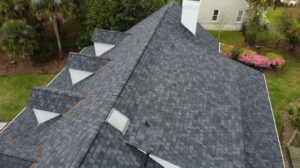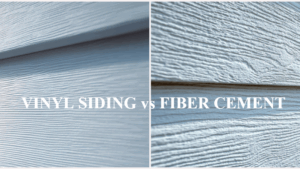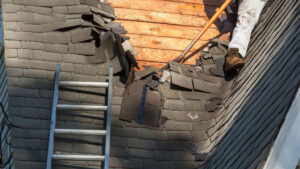As a professional with advanced roofing knowledge, I understand the importance of knowing your roof’s life expectancy. The lifespan of your roof ultimately depends on various factors, such as weather conditions and roofing materials used during installation. In this blog post, you will learn about the average lifespan of common roofing materials, including asphalt shingles, metal roofs, flat roofs, slate roofs, wood shingles, and composite shingles.
We will discuss how to determine if it is time for a roof replacement or repair by identifying signs of damage that can affect your roof’s health. Additionally, we will explore some durable materials that can extend the life span of your roof and provide tips on how to maintain it over time.
If you are looking for an expensive roofing material or want to know more about architectural shingles and three-tab asphalt shingles, keep reading! This article covers the effects of weather on various roof types, enabling homeowners to make informed decisions when selecting a new covering for their residences.
In summary, this blog post provides comprehensive information about everything related to a roof’s life expectancy, which every homeowner should know in order to protect their investment in their home!
What Is The Average Lifespan Of A Roof?
The expected longevity of a roof can vary, depending on the material employed, but typically spans from 15 to 30 years. Metal roofs are known for their durability and can last up to 50 years or more with proper maintenance. Shingle roofs have an average life expectancy of 20-30 years, depending on the quality and installation of the shingles. Flat roofs, while less long-lasting than sloped ones, can still provide up to two decades of service with regular upkeep and repairs. Slate roofs are one of the most expensive roofing materials available, but they also boast some of the most extended lifespans at 75+ years if properly maintained.
Asphalt shingle roofs are a common roofing choice, usually providing 15-20 years of protection before needing to be replaced. Architectural shingles offer increased durability compared to traditional three-tab asphalt shingles so that you may get closer to a 25-30 year life span out them depending on weather conditions in your area and how well you maintain them over time. Wood shingles or shakes can also be expected to last around 20-25 years when installed correctly. In contrast, composite shingle products such as synthetic slate will often exceed 30-year lifespans if adequately maintained throughout their lifetime.
Regularly inspecting your roof for signs of damage or wear is essential to preserving its life expectancy and avoiding costly repairs. Even minor issues like missing granules should be addressed immediately by a professional roofer experienced in working with your particular material type. With regular maintenance and timely repairs, any roof should reach its entire potential life span; just make sure not to skimp on quality when selecting materials.
The life expectancy of a roof is contingent on various aspects, including the kind and excellence of materials utilized in its fabrication. Knowing these factors can help homeowners make informed decisions when considering roof repair or replacement. Next, we’ll explore the various components influencing a roof’s life expectancy.
Key Takeaway: The life expectancy of a roof can differ significantly depending on the kind and quality of material employed, but usually falls within 15-50 years with consistent upkeep. Asphalt shingles are a common choice, offering 15-20 years of use with proper upkeep, while architectural shingles may provide up to 25-30 years. To maximize its full potential life span, it is important not to cut corners when selecting materials or neglect routine inspections for signs of wear and tear.
Factors That Impact Roof Lifespan
The climate is one of the most significant factors that can impact a roof’s lifespan. Extreme weather conditions, such as hail, strong winds, and heavy snowfall, can damage the roof’s shingles and other components. In addition, extreme hot and cold temperatures can also take their toll on a roof over time. Asphalt shingles are particularly susceptible to heat damage in warmer climates; they may become brittle or warped due to excessive exposure to UV rays from the sun. Asphalt shingles can become brittle and easily breakable in cold climates due to extreme temperatures.
Maintenance is another key factor in determining how long your roof will last. Regular inspections by a professional contractor are essential for detecting any potential problems before they become major issues that require costly repairs or replacements. Additionally, regularly cleaning debris off your roof (such as leaves or branches) helps ensure it remains structurally sound for more prolonged periods since these materials can trap moisture which could lead to mold growth or water infiltration if left unchecked for too long.
Comprehending the components influencing your roof’s life expectancy is critical for making enlightened decisions about repairs or replacements. With this knowledge, it is possible to recognize when a roof needs replacing before severe damage occurs. Subsequently, it is essential to be aware of the indications that could signify a need for roof replacement.
Key Takeaway: Climate extremes, such as high winds and extreme temperatures, can take a toll on roofs over time; however proper maintenance from a professional contractor is essential for keeping your roof in top shape. Regular inspections and debris removal will help ensure that your roof stands the test of time.
Signs Your Roof Needs Replacing
Do your due diligence before committing to a roofing material; life expectancies vary based on the type and quality of materials used, weather conditions, and regular maintenance. Metal roofs are known for longevity – they can easily last 50 years or more with proper care. Asphalt shingle roofs typically have an average lifespan of 15-20 years, while flat roofs need replacing every 10-20 years because they’re susceptible to water damage from pooled rainwater. If budget is an issue, consider options other than slate roofs since these are expensive but long-lasting. For wood shingles, composite shingles, architectural shingles, and three-tab asphalt shingles, it’s essential to weigh up durability against cost factors to get a bang for your buck.
Regular inspections by a professional should be done at least once per year or after any severe storms that could cause damage to maintaining the health of your roof over time. If left unchecked, minor issues can become major problems requiring costly repairs or even complete replacement down the road; this makes regular maintenance essential for extending your roof’s lifespan as much as possible.
If you notice any signs that suggest your roof might need replacing – such as cracked, curled, or missing shingles; water stains on ceilings or walls; excessive moss growth; etc., you must call a professional right away for an inspection before further damage occurs.
Signs that your roof needs replacing should be addressed, as they can lead to serious damage and costly repairs. Sustaining the roof’s durability necessitates consistent upkeep, making it essential to recognize the rewards of regular care for long-term effectiveness.
Key Takeaway: Investigating and weighing up the options when deciding on a roofing material is critical, as life spans can differ significantly. Regular maintenance is key for extending the lifespan of any roof, so yearly inspections should be carried out by an expert – catch small problems before they become big headaches.
Benefits Of Regular Maintenance
Regular maintenance of your roof is essential for ensuring its longevity. A well-maintained roof can last up to twice as long as an unmaintained one, so it’s important to stay on top of regular inspections and repairs. Regular maintenance can reduce the risk of expensive roof replacements due to weather or other issues.
The life expectancy of a roof ultimately depends on the type of material used and the environment it’s exposed to. Metal roofs are generally more durable than shingle roofs but are also more expensive upfront. Shingle roofs typically have a lifespan between 15-30 years, depending on their quality and how well they’ve been maintained over time. Flat roofing can last between 10 and 20 years, while slate roofs may last up to half a century with suitable upkeep. Ascending in popularity, architectural shingles are known for their longevity and cost-efficiency, with a potential lifespan of up to 30 years or longer when adequately cared for.
It’s important that homeowners inspect their roofs at least once a year for any signs of wear or damage, such as cracked tiles, missing nails, broken seals around flashing points, moss growth, algae stains, or water leaks inside the house. Regular cleaning should also be done annually using soft brushes or pressure washers set at low-pressure levels; this helps prevent debris build-up, leading to rot and decay over time if not addressed quickly enough. Additionally, ensure that gutters are cleared regularly throughout fall/winter months since clogged gutters can cause water build-up near eaves which could eventually seep into your home’s interior walls leading to mold growth down the line – not something anyone wants.
When dealing with more significant issues like replacing worn-out materials (such as three-tab asphalt shingles) or installing new ones (like wood shakes), it’s best practice always to call in professional help when necessary. Attempting DIY projects involving high altitudes puts you at risk for serious injury. Professionals know exactly what materials work best given certain weather conditions so that they can provide valuable advice during installation and guarantee quality results afterward. This peace of mind only comes with hiring experienced professionals who take pride in doing good work every time.
Keeping up with your roof can assist in increasing its longevity and help you save money over time. Hence, it is essential to be aware of this when seeking an expert for aid with restorations or replacements.
Key Takeaway: With regular inspections and maintenance, a roof can last up to twice as long. The life expectancy of a roof depends on the type of material used and how well it is maintained; metal roofs are more durable than shingle roofs but costlier upfront. Professional help should be sought when dealing with larger issues like replacing worn out materials or installing new ones – this ensures quality results in the end.
When To Call A Professional
When it comes to roofing, the most important thing is to know when it’s time to call a professional. Knowing the average lifespan of your roof and being aware of signs that indicate replacement or repair are key components in maintaining its health.
The life expectancy of a roof ultimately depends on the material used. Metal roofs have an expected life expectancy of 40-70 years, while shingles may last from 20-30 depending on the elements and quality. Slate roofs can last up to 100 years with proper maintenance, but they come at an expensive price tag due to their durability. Asphalt shingle roofs tend to be one of the more common roofing materials, lasting anywhere from 15-20 years, depending on quality and weather conditions. Flat roofs typically require more frequent repairs than other types due to their design, so keep that in mind if you’re considering this option for your home’s new roof.
Homeowners should be alert for any indications that their roof might need replacing or mending, such as missing tiles/shingles, fading of color, curled corners, drooping patches, and water spots inside the house. These could point to leaking through cracks in ceilings or walls and mold growth near windowsills or ceilings – all are red flags signaling it’s time for a new roof. Keywords: Roof Replacement; Repair; Warning Signs; Missing Shingles; Discoloration/Fading; Curling Edges; Sagging Spots; Water Stains Inside Home; Leaking Through Cracks In Ceilings Or Walls; Mold Growth Near Windowsills Or Ceilings.
Annual gutter inspections (especially after severe weather) and periodic checks of seals around chimneys, skylights, and vents every few months will help keep costly repairs at bay. Additionally, trimming trees in the vicinity regularly can be instrumental in preserving your roof’s performance over time. Keywords: Roof Maintenance; Gutter Inspections; Seals Around Chimneys/Skylights/Vents; Trimming Nearby Trees Regularly.
Key Takeaway: A roof’s life-span can range from two to seven decades, depending on the material employed; metal roofs may endure 40-70 years while shingle ones tend to last 20-30. Warning signs that replacement or repair may be necessary include missing shinglestiles, discolorationfading, curling edges, sagging spots and water stains inside the home. Regular maintenance such as gutter inspections and trimming nearby trees can help preserve your roof’s performance over time.
FAQs In Relation To Lifespan Of A Roof
What is the typical life expectancy of a roof?
The typical life expectancy of a roof depends on several factors, such as the type of material used, the climate in which it is installed, and how well it has been maintained. Generally, asphalt shingles may survive 20-25 years, while metal roofings can endure up to 50+ years with suitable upkeep. A tile roof may last even longer with proper maintenance. It is essential to keep in mind that regular inspections and repairs are necessary for any roofing system to ensure its longevity.
Does a 30 year roof last 30 years?
No, a 30-year roof does not necessarily last 30 years. The lifespan of a roof is dependent on the quality and type of materials used, installation methods, weather conditions in the region, maintenance practices, and more; all these elements can determine whether it will last longer than its designated 30 years. A properly installed and maintained 30-year roof can often exceed its expected life expectancy; however, it is essential to remember that all roofs eventually need replacement or repair due to normal wear and tear.
How do you determine the life of a roof?
The age of the roof can also be an indicator. Generally, asphalt shingle roofs last 15-30 years, while metal roofs can last up to 50 years or more. Regular maintenance, such as cleaning gutters and trimming trees that overhang the roof, will help extend its lifespan. Ultimately, having a professional inspect your roof regularly is the best way to ensure you get accurate information about its condition and remaining life expectancy.
What’s the longest a roof can last?
The longevity of a roof is mainly contingent on the material employed and its upkeep. The typical lifespan of asphalt shingles ranges from 15-30 years, metal roofs can last up to half a century, and tile or slate may endure for more than a hundred years with appropriate maintenance. However, extreme weather conditions may shorten these expected lifespans significantly. Regular inspections by a professional contractor are recommended to identify potential issues before they become costly repairs or replacements.
Conclusion
Understanding the average lifespan of a roof, being aware of factors that can affect this timeline, recognizing signs that replacement may be necessary, and scheduling professional inspections when needed will ensure your roof remains in good condition for years to come. Remember: taking care of your roof now could save you time and money.
Let Designer Roofing & Restoration help you maximize the lifespan of your roof with our experienced and reliable services. Contact us today to learn more about how we can keep your home safe and secure!





